Hummingbirds can only be observed in the Western Hemisphere, with nearly half of all species dwelling in the “equatorial belt” around 10 ° south and north of the equator.
The hummingbird family is relatively extensive, including over 115 genera and 330 species, among which the majority are found in the southern United States.
Hummingbirds are members of the Trochilidae family and are one of the tiniest birds, with many of these species averaging 3 inches to 5 inches.
Several hummingbirds spend their entire winter across Mexico or Central America before migrating north to their breeding habitats in the southern United States as early as February and farther north in the spring.
Males are generally the first to arrive in the spring.
Approximately two dozen species enter Canada and the United States, and just a few stay year-round.
How to Identify a Hummingbird?
Hummingbirds are one of the most popular birds, yet recognizing them may be difficult. They are little and agitated.
Their color pattern may also be difficult to identify on such a little body, and it may seem different from various perspectives. Hummingbirds may seem dark or black under poor light.
Consider the following
Bird identification necessitates paying careful attention to a bird’s size, color patterns, shape, geographical region, behavior, season, and environment.
When referring to hummingbirds at feeders (where they are most likely to be observed), one must pay attention to the bird’s color patterns as well as the season and time of year of the observation.
Tips for Hummingbird Identification
Males
Take note of the crown and neck (gorget) forms and colors, as well as the chest and belly’s color patterns.
- What color is their throat?
- Is the gorget solidly colored, striped, or elongated?
- Is the crown iridescent as well or plain?
- What are the chest and abdominal colors?
Females
Female hummingbirds may be difficult to recognize. Females are almost always the identical species as that to the males that follow them towards the feeders.
Take note of the head markings as well as the color patterns on the breast and abdomen.
- Is there a noticeable supercilium?
- Are the breasts and abdomen pale or buffy brown in color?
- Is there a ring of iridescent plumage in the middle of the throat?
Female hummingbirds possess different color patterns on their tails, although these are hard to identify. Remember that certain females are so identical across species that they can’t be properly recognized.
All species’ males and females possess greenish or green upper parts.
Types Of Hummingbirds and their Identification
1. Lucifer Hummingbird
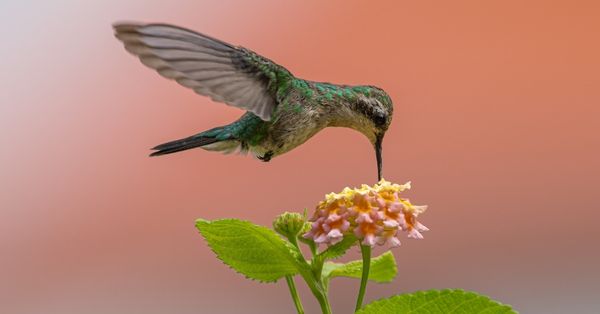
| Scientific Name | Calothorax Lucifer |
| Bill | decurved, black |
| Male Throat | Pink to Purple |
| Female Throat | Plain |
| Tail | Forked |
| Length | 3.7 inches (2.6 cm) (3.1 gr) |
| Weight | 0.11 ounces |
| Range | Rare/Southwest |
| Other | Females show buff-colored underparts |
Identification
Adult males have a black forked tail and a magenta or purple gorget. Females have such a buffy supercilium and a breast line, as well as reddish colored at the end of the outer tail feathers.
The beak of both sexes is long and curved. Juveniles have a feminine appearance.
Migration
Spring migration occurs mostly in the United States from early March to early April. Fall migration starts during mid-August and lasts until early October.
Breeding
From early April to mid-August, the breeding season lasts. The female constructs a cup-shaped nest on short-stemmed plants.
The nest is located between 0.8 and 1.5 meters above the ground. She hatches two whitish eggs that are unmarked.
Habitat
It prefers mixed grassland with shrubs and cacti at altitudes ranging from 3,500 to 5,500 feet.
Lifespan
Lucifer Hummingbird has a lifespan of 3 to 5 years.
How many are there in total?
According to Partners in Flight, there are around 200,000 Lucifer Hummingbirds throughout the world.
Interesting Facts
Females Lucifer Hummingbird may construct a new nest on top of an old one.
Males don’t really put on a show but, instead, linger around the female when she is on or constructing the nest.
2. Violet-crowned Hummingbird
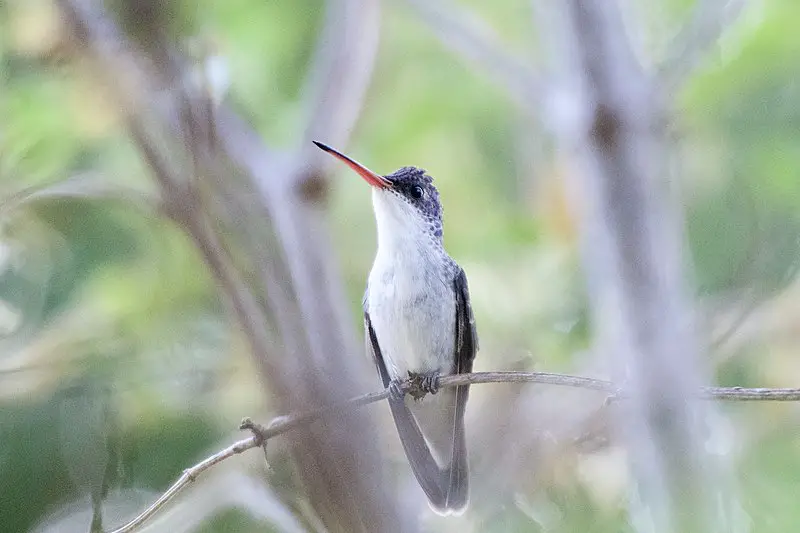
| Scientific Name | Amazilia violiceps |
| Bill | Straight red with black tip |
| Throat | Plain white |
| Tail | When spread slightly curved |
| Length | 5.6 inches (5.5 gr) |
| Range | rare/southwest |
| Weight | 0.619 ounces |
| Other | both genders are similar, showing a blue-purple crown |
Identification
The upper parts and tail of adult birds are greenish-brown. The crown is purple. The bill is a vibrant scarlet with a darkish end. The underparts are completely white.
Both sexes have similar appearances.
Migration
Very little is documented about its migrations in its narrow distribution in the United States. Birds start to come to Arizona around mid-February, depending on their appearance at bird feeders; however, some birds overwinter across the state.
Breeding
The breeding season lasts from around mid-March until mid-September. The female constructs a cup-shaped nest on sycamore trees.
The nest is located between 7 and 12 meters above the surface. She hatches two white eggs that are unmarked.
Habitat
At altitudes ranging from 1,200 to 1,700 meters, it prefers dry mixed scrub with pine-oak woodlands and riparian evergreen canyons.
Lifespan
A Violet-crowned Hummingbird may live for at least six years.
How many are there in total?
Violet-crowned Hummingbird has a worldwide estimated population of about 2 million.
Interesting Facts
It’s the only hummingbird across North America with all-white underparts.
It nearly always nests in the Arizona sycamore tree.
3. Buff-bellied Hummingbird
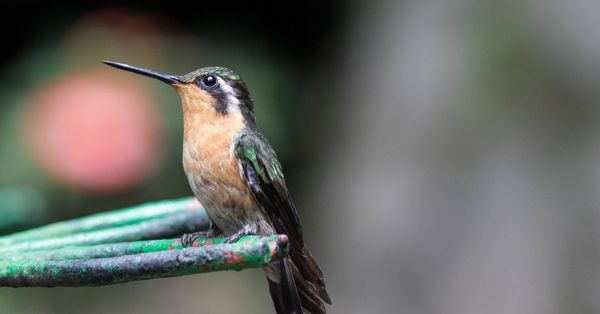
| Scientific Name | Amazilia yucatanensis |
| Bill | slightly decurved red with a black tip |
| Throat | black to green |
| Tail | black to green |
| Weight | 0.13 ounces |
| Length | 4.2 inches (2.6 centimeters) (3.8 gr) |
| Range | South Texas |
| Other | both genders are similar and show pale buff underparts |
Identification
Green on the head, chest, and upper back. The stomach is buffy. The bill is a vibrant scarlet with a dusky apex. Both sexes resemble each other; however, males have a rufous tail and more intense colors than females.
Migration
This hummingbird spends much of its time resting. From October and February, after the mating season, many individuals migrate to the southern states of the United States.
Breeding
The Buff-bellied Hummingbird nests from around the middle of March until the middle of September. The female constructs a cup-shaped nest 1 to 3 meters above the surface. She hatches two white eggs that are unmarked.
Habitat
The Buff-bellied Hummingbird has been an ecological generalist that may be observed at low altitudes near forest borders, parks, playgrounds, and scrubby forests.
Lifespan
Lifespan of a Buff-bellied Hummingbird is approximately 11 years.
How many are there in total?
There are around 2 million Buff-bellied Hummingbirds throughout the world.
Interesting Facts
It’s one of the least researched of the North American hummingbirds.
Unlike other migratory birds, several migrate to the Northeastern United States during the winter or nonbreeding season.
4. Broad-billed Hummingbird

| Scientific Name | Cynanthus latirostris |
| Bill | straight, black tip, red base, thick base |
| Throat | Male: blue to green, Female: gray |
| Tail | Slightly forked |
| Length | 5 inches |
| Weight | 0.3 ounces (7.6 gr) |
| Range | Southern Arizona |
| Other | Wags and flips tail when Flying |
Identification
The male is primarily green, having blue on his neck and chest. The tail is notched and black. The bill appears coral-red in color, with a dark apex. The female does have a white supercilium and dingy grey underparts.
Migration
The spring movement takes place across SE Arizona during March. The fall migration begins around mid-September and lasts until mid-October.
Breeding
From early May until September, birds throughout the United States seem to nest.
The female makes a cup-shaped nest 3 to 10 feet above the surface. Females hatch two to three white eggs that are unmarked.
Habitat
The Broad-billed Hummingbird prefers riparian environments near rivers and valleys below 6,500 feet in altitude in its limited distribution in the United States.
Lifespan
The lifespan of a Broad-billed Hummingbird is approximately nine years.
How many are there in total?
Broad-billed Hummingbird has a worldwide breeding population of around 2.2 million individuals.
Interesting Facts
A male Broad-billed Hummingbird courting existing data of the male flying in a pendulum motion above the female.
5. Blue-throated Mountain-Gem

| Scientific Name | Lampornis clemenciae |
| Bill | straight, black |
| Tail | broad white corners |
| Throat | Male: blue, Female: gray |
| Length | 5 inches |
| Weight | 0.3 ounces (7.6 gr) |
| Range | rare/southwest |
| Other | exceptionally large size, white stripe noticeable on the face, dull underparts |
Identification
A sapphire-blue gorget adorns the man. Both sexes possess grey underparts, a black tail with a white apex, and a double white line all around the eye.
Migration
Birds began to arrive around mid-March in their restricted range in the United States. Most birds had departed the United States by late October, although some overwinter around feeding sites.
Breeding
The Blue-throated Mountain Gem begins breeding in Arizona in early April and continues until mid-August. Females may have many broods in a single season.
Habitat
The Blue-throated Mountain-Gem prefers mixed woods and deciduous forests across the mountains of the United States. It is common at altitudes ranging from 4,500 to 11,500 feet. It is uncommon at lower altitudes.
Lifespan
Lifespan of a Blue-throated Mountain Gem is approximately seven years and eleven months.
How many are there in total?
There are around 2 million Blue throated mountain gem worldwide.
Fun Facts
The Blue-throated Mountain-Gem might be the biggest hummingbird throughout North America. It’s three times bigger than a Ruby-throated Hummingbird.
Since mid-2019, it has been recognized as the Blue-throated Hummingbird.
6. Anna’s Hummingbird
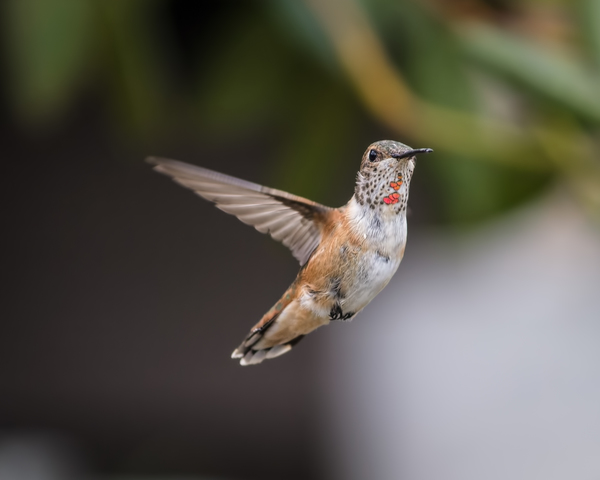
| Scientific Name | Calypte anna |
| Bill | straight, black |
| Throat | Male: pink to red, Female: splotched or streaked |
| Tail | Male: forked and Female: slight white corners |
| Length | 4.1 inches |
| Weight | 0.16 ounces (4.3 gr) |
| Range | year-round Pacific coast and southwest |
| Other | males have pink to red crowns and forehead |
Identification
The male does have a light eyering and an iridescent crimson head and throat. The underparts have a green color. Females have a white stripe across their eyes and greener underparts. She has a central red spot on her neck. Her tail features a black ring with a white end.
Migration
Anna’s Hummingbird has been a sedentary and resident species. They migrate down and up the mountainous regions after breeding, possibly in reaction to weather and flower availability fluctuations.
Breeding
Breeding time varies between birds across California and those living in the northern half of their range. Anna’s Hummingbirds start nesting during mid-January and continue until early May.
The female constructs a cup-shaped nest 2 to 6 meters above the surface. She hatches two white eggs that are unmarked.
Habitat
Anna’s Hummingbirds like open woods, oak savannas, chaparral, and coastal scrub. They are widespread in suburban areas and other man-made environments.
Lifespan
Anna’s Hummingbird has a lifespan of approximately eight years and 2 to 3 months.
How many are there in total?
The worldwide nesting population of Anna’s Hummingbird is predicted to be 5 million.
Interesting Facts
Anna’s Hummingbirds’ habitat has grown owing to the availability of blooming plants across urban areas and also hummingbird feeders.
Native American stories tell of Anna’s hummingbirds piercing tunnels in the night sky, which eventually became stars.
7. Costa’s Hummingbird
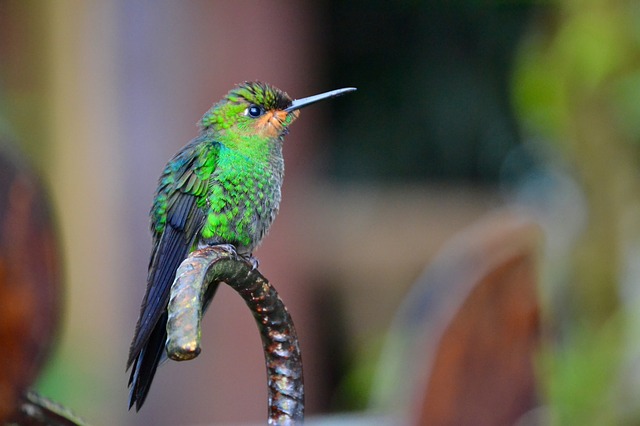
| Scientific Name | Calypte costae |
| Bill | straight, black |
| Throat | Male: pinkish to purple, Female: plain |
| Tail | straight across |
| Size | 3.5 inches |
| Weight | 0.1 ounces (3.1 gr) |
| Range | Pacific coast, southwest |
| Other | males show purple to pink on the crown and forehead |
Identification
The male Costa’s Hummingbird does have a violet extended gorget and also an iridescent purple crest. Females have whitish underparts and prominent white supercilium. Her tail features a wide black band topped with big white dots.
Migration
Costa’s Hummingbird migratory habits are irregular and remain unclear. Spring migration takes place from early January until mid-March. Fall migration seems to take place between the middle of April and the middle of June.
Breeding
Nesting behavior varies according to habitat location and type. Birds started nesting across California and Arizona during February and continued until May.
The female constructs a cup-shaped nest on a straight tree 1 to 2 meters above the surface, wherein she hatches two unmarked whitish eggs.
Habitat
Throughout its habitat, the Costa Hummingbird prefers desert scrub, deciduous woodland, coastal California chaparral, and sage scrub.
Lifespan
Depending on a bird banded and recaptured in California, the Costa Hummingbird has a lifespan of about eight years and nine months.
How many are there in total?
Costa Hummingbird has a worldwide nesting population of around 3.4 million.
Interesting Facts
According to research on Costa’s Hummingbird hunting activities, birds must visit 1,840 flowers every day to meet the bird’s energy needs.
Costa’s hummingbirds may fly far from home. Birds have been seen as far north as Alaska and British Columbia.
8. Black-chinned Hummingbird
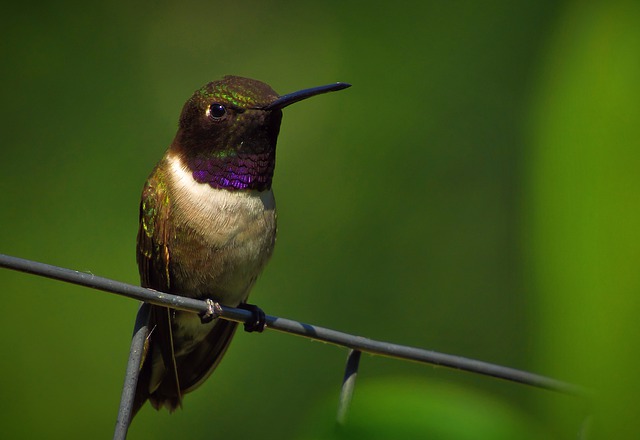
| Scientific Name | Archilochus alexandri |
| Bill | straight, black |
| Throat | Male: purple and black, Female: faintly streaked or plain |
| Tail | slightly forked |
| Length | 3.7 inches |
| Weight | 1.6 ounces (2.7 gr) |
| Range | widespread in the west |
| Other | white collar contrasts with the male’s throat, active tail movement while feeding |
Identification
The male does have a black face that is bordered underneath by an iridescent violet line. It possesses a black tail. The female does have a speckled throat. She has thick black bands on her tail that are topped with huge white dots.
Migration
Arriving and departing timings vary per area. The Spring migrations last from mid-March until mid-May. Fall migration happens from early August until late September.
Breeding
The breeding season for birds across the United States varies, although it generally extends from mid-May to early August. The female makes a cup-shaped nest 6 to 12 feet from the ground. She hatches two unmarked whitish eggs.
Habitat
It is an environmental generalist that lives in dry scrub, cities, forests, and other man-made environments.
Lifespan
The lifespan of a Black-chinned Hummingbird is approximately 11 years and two months.
How many are there in total?
The worldwide nesting population is predicted to be 5 million.
Interesting Facts
Throughout the migration, birds make short stops and seem to fly straight to their nesting sites.
Females are somewhat bigger as compared to males.
9. Ruby-throated Hummingbird

| Scientific Name | Archilochus colubris |
| Bill | straight and black |
| Throat | Male: Red and Female: Plain |
| Tail | Male: Slight fork and Female: White tips |
| Length | 3.8 inches |
| Weight | 0.12 ounces (3.2 gr) |
| Range | East |
| Other | only hummingbirds widely spotted in the east |
Identification
The male has an iridescent-red gorget surrounded by a light crescent on the underside. It has a greenish abdomen and a black tail.
The female’s neck is speckled, and her underparts are dull-greenish. Her tail features a wide black band that is topped with big white dots.
Migration
They breed primarily throughout the eastern half of the United States. Mexican birds appear across the southern states throughout late February and leave in late October. Several individuals spend the winter across the southeastern states.
Breeding
Birds appear mostly in southern states first, followed by the northern states. As a result, the nesting season begins and concludes on separate occasions.
Overall, mating occurs from May to September. The female constructs a cup-shaped nest 10 to 40 feet above the surface. She hatches two white eggs that are unmarked.
Habitat
Ruby-throated Hummingbirds can live in a wide range of environments. They prefer trees and shrubs in forests but can be observed throughout orchards, old fields, meadows, forest edges, and backyards as well.
Lifespan
A Ruby-throated Hummingbird’s typical life expectancy is roughly 9 years and 60 days, based on a bird banded and recaptured in West Virginia.
How many are there in total?
The worldwide nesting population of the Ruby-throated Hummingbird is predicted to be 20 million.
Interesting Facts
Ruby-throated Hummingbirds enjoy red and orange flowers.
Ruby-throated Hummingbirds frequently nest in unusual locations, including power cables, electric lines, extension cords, and metal bars in barns.
10. Calliope Hummingbird
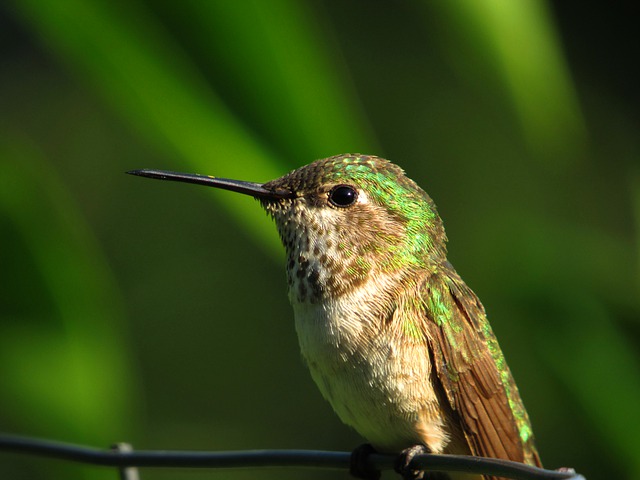
| Scientific Name | Selasphorus calliope |
| Bill | straight, black |
| Throat | Male: magenta to pink streaks, Female: faintly streaked |
| Tail | Male: black, Female: white tips |
| Size | 3.27 inches |
| Weight | 0.1 ounces (2.7 gr) |
| Range | Interior west, Pacific Northwest |
| Other | Tiniest of the North American hummingbirds |
Identification
The male Calliope Hummingbird does have a gorget that is striped with iridescent pink. A white line runs from the bottom of the bill towards the neck. It has a long, black tail.
The female’s neck is speckled, and her underparts are light buffy. Her tail features a wide black band that is topped with big white dots.
Migration
Throughout Mexico, the whole inhabitants spend the winter. Birds started to migrate to the United States in early March and continued through May. Birds returned to Mexico mostly in fall, beginning in mid-June and lasting until late September.
Breeding
Birds throughout the United States begin nesting in late April and continue until mid-August. The female constructs a cup-shaped nest 6 to 39 feet above the surface. She hatches two white eggs that are unmarked.
Habitat
The Calliope Hummingbird is often a highland species that breed at altitudes ranging from 1,200 to 3,400 feet, mostly in the United States. It prefers forest margins and typically accompanies low shrubs and scrub plants.
Lifespan
The lifespan of a Calliope Hummingbird is approximately 8 years and 30 days.
How many are there in total?
The worldwide nesting population of the Calliope Hummingbird is predicted to be 4.5 million.
Interesting Facts
They are very aggressive, mobbing and chasing away every bird, even hawks, and crows.
For such a little bird, they travel 5,000 kilometers to the north coast and then back to nesting grounds.
Conclusion
This article is all about Hummingbird species and their identification characteristics, breeding, habitats, and other vital facts.
You will be able to recognize the hummingbird species after reading this article. Please let us know if you require any additional help. Thank You.
FAQ
How many hummingbird species are there?
About 350 hummingbird species have been identified, with new species getting reported each year. There were apparently two additional species of hummingbirds that became extinct after being found in the nineteenth century.
Which hummingbird is among the most common?
The Ruby-Throated Hummingbird is a common species, primarily found in Canada and Central and Eastern United States.
Many species may be found in the Gulf area. Hummingbirds such as Allen’s, Anna’s, Calliope, White-eared, Black-Chinned, Broad-Tailed, and Rufous may be found throughout the Western United States.
Last Updated on March 22, 2023 by Lily Aldrin

I live in central PA and just saw a hummingbird about 7cm with very clear bright green covering both sides of its back but not the middle.. It drank from my feeder then disappeared. In my bird book the only one with that kind of bright green back lives
in Peru, and Ecuador. Do you know if that could be possible?
Thank you
Hello, there was a completely yellow hummingbird in my yard today. First time I’ve ever seen one. It hovered twice, then took off. Was this a tropical bird that got blown off course?
Is there way that I can submit pictures of hummingbirds that I have so I can confirm which ones come to my yard during summer
Same here, we have a hummingbird we can’t identify. Can we submit a picture? So Cal.